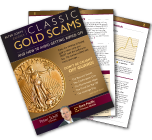This week, we’re reporting on one of the wackier gold scams that’s arisen amidst the recent gold buying frenzy: scammers in British Columbia have been trying to sell gold that was (allegedly) smuggled into the United States from Iraq, where it was (allegedly) first owned by Osama Bin Laden. These scammers operate in parking lots, using high-pressure sales tactics. They’ve succeeded in selling hundreds of dollars of fake gold to one customer, and outright stole gold off another man by switching his genuine gold chain with a fake one.
There’s so much wrong with this scenario. Right off the bat, you should be highly suspicious of any gold dealer who’s doing business in a parking lot or similarly non-professional environment. Approaching random people and asking them to buy gold is a sales strategy that reeks of desperation. It is not a strategy that any dealer who buys and sells in bulk would ever adopt. Rather, unprofessional settings are a huge red flag that the dealer is merely looking for a quick buck – and then a quick escape.
Furthermore, it’s unwise for gold investors to choose numismatics (e.g. collector’s coins), especially when they are only casual purchasers with little knowledge of the markets for such items. In this case, the scammers were peddling jewelry, which is similarly problematic. Only part of a piece of jewelry’s worth comes from the metals contained in it. Another part of its value is derived from the utility that the jewelry has as a wearable object.
However, remember that your goal as an investor is simple: to use precious metals for storing and protecting your wealth. Don’t let yourself be distracted by fancy “historical” coins, chains, and rings – when it comes to wealth protection, simple and highly liquid forms of gold, like American Eagles, Canadian Maple Leafs, and bars sold by weight, are best. You can sell these easily if you need to, without having to convince any purchaser of their special properties.
Because they are marked clearly and reliably by weight, you can also more easily tell what price is reasonable to pay for standard coins and bars. As we discussed last time here on the Gold Scams blog, 7% or less has been a reasonable markup to pay over spot for gold, but for silver that figure has recently increased to more like 20%. If you are buying mystery coins and jewelry from a shady dealer in a parking lot, it’s going to be difficult to tell offhand how much gold those items really contain and therefore how much would be reasonable to pay for them. Assuming that the items being offered contain any real gold at all, the chance of finding a fair markup in a parking lot is highly unlikely.
Last but certainly not least, don’t allow a dealer to push your emotional buttons with an attention-grabbing claim, like that the gold was previously owned by someone famous. The Osama Bin Laden claim was apparently the dealer’s last-ditch attempt to make prospective buyers feel like a really special, once-in-a-lifetime opportunity was at hand, and that they should jump on it immediately. But, unless you’re an expert on numismatics or historical jewelry, it just doesn’t matter that your gold be unique in its form or in its alleged history.
Stay focused on your goal: buying well-known, liquid forms of gold at as low of a markup as possible, for the purpose of storing and protecting wealth. Don’t let yourself be led astray by claims about special gold, with an interesting history or medium. The Bin Laden gold scammers may have had a particularly far-fetched story, but unwitting buyers are taken in by claims about special gold every day.
Thanks for reading and sharing. Join us again next week for another installment of our series on scams during the current precious metals buying frenzy.


